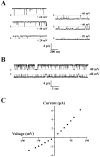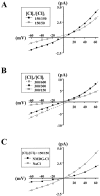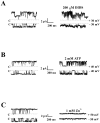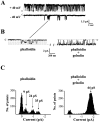Cytoskeletal actin gates a Cl- channel in neocortical astrocytes
- PMID: 9464993
- PMCID: PMC2712127
- DOI: 10.1523/JNEUROSCI.18-05-01679.1998
Cytoskeletal actin gates a Cl- channel in neocortical astrocytes
Abstract
Increases in astroglial Cl- conductance accompany changes in cell morphology and disassembly of cytoskeletal actin, but Cl- channels underlying these conductance increases have not been described. We characterize an outwardly rectifying Cl- channel in rodent neocortical cultured astrocytes and describe how cell shape and cytoskeletal actin modulate channel gating. In inside-out patch-clamp recordings from cultured astrocytes, outwardly rectifying Cl- channels either were spontaneously active or inducible in quiescent patches by depolarizing voltage steps. Average single-channel conductance was 36 pS between -60 and -80 mV and was 75 pS between 60 and 80 mV in symmetrical (150 mM NaCl) solutions. The permeability ratio (PNa/PCl) was 0.14 at lower ionic strength but increased at higher salt concentrations. Both ATP and 4, 4-diisothiocyanostilbene-2,2'-disulfonic acid produced a flicker block, whereas Zn2+ produced complete inhibition of channel activity. The frequency of observing both spontaneous and inducible Cl- channel activity was markedly higher in stellate than in flat, polygonally shaped astrocytes. In addition, cytoskeletal actin modulated channel open-state probability (PO) and conductance at negative membrane potentials, controlling the degree of outward rectification. Direct application of phalloidin, which stabilizes actin, preserved low PO and promoted lower conductance levels at negative potentials. Lower PO also was induced by direct application of polymerized actin. The actions of phalloidin and actin were reversed by coapplication of gelsolin and cytochalasin D, respectively. These results provide the first report of an outwardly rectifying Cl- channel in neocortical astrocytes and demonstrate how changes in cell shape and cytoskeletal actin may control Cl- conductance in these cells.
Figures










Similar articles
-
Whole-cell chloride currents in rat astrocytes accompany changes in cell morphology.J Neurosci. 1996 Apr 15;16(8):2532-45. doi: 10.1523/JNEUROSCI.16-08-02532.1996. J Neurosci. 1996. PMID: 8786429 Free PMC article.
-
Volume-activated chloride currents in interstitial cells of Cajal.Am J Physiol Gastrointest Liver Physiol. 2005 Nov;289(5):G791-7. doi: 10.1152/ajpgi.00050.2005. Am J Physiol Gastrointest Liver Physiol. 2005. PMID: 16227526
-
Characterization of an inwardly rectifying chloride conductance expressed by cultured rat cortical astrocytes.Glia. 1997 Oct;21(2):217-27. doi: 10.1002/(sici)1098-1136(199710)21:2<217::aid-glia5>3.0.co;2-3. Glia. 1997. PMID: 9336236
-
Conductance-voltage relations in large-conductance chloride channels in proliferating L6 myoblasts.Gen Physiol Biophys. 1994 Jun;13(3):171-92. Gen Physiol Biophys. 1994. PMID: 7835680
-
Role of the actin cytoskeleton in the regulation of the cystic fibrosis transmembrane conductance regulator.Exp Physiol. 1996 May;81(3):505-14. doi: 10.1113/expphysiol.1996.sp003953. Exp Physiol. 1996. PMID: 8737083 Review.
Cited by
-
Astrocytes: new evidence, new models, new roles.Biophys Rev. 2023 Oct 18;15(5):1303-1333. doi: 10.1007/s12551-023-01145-7. eCollection 2023 Oct. Biophys Rev. 2023. PMID: 37975000 Free PMC article. Review.
-
Mechanisms of Activation of Brain's Drainage during Sleep: The Nightlife of Astrocytes.Cells. 2023 Nov 20;12(22):2667. doi: 10.3390/cells12222667. Cells. 2023. PMID: 37998402 Free PMC article. Review.
-
Modulation of RhoGTPases improves the behavioral phenotype and reverses astrocytic deficits in a mouse model of Rett syndrome.Neuropsychopharmacology. 2012 Apr;37(5):1152-63. doi: 10.1038/npp.2011.301. Epub 2011 Dec 7. Neuropsychopharmacology. 2012. PMID: 22157810 Free PMC article.
-
Effect of P2 receptor on the intracellular calcium increase by cancer cells in human umbilical vein endothelial cells.Naunyn Schmiedebergs Arch Pharmacol. 2008 Jun;377(4-6):429-36. doi: 10.1007/s00210-007-0259-2. Epub 2008 Jan 22. Naunyn Schmiedebergs Arch Pharmacol. 2008. PMID: 18210093
-
Cytoskeleton as a potential target in the neuropathology of maple syrup urine disease: insight from animal studies.J Inherit Metab Dis. 2007 Oct;30(5):664-72. doi: 10.1007/s10545-007-0562-6. Epub 2007 Jun 14. J Inherit Metab Dis. 2007. PMID: 17574538 Review.
References
-
- Cantiello HF, Stow J, Prat AG, Ausiello DA. Actin filaments control epithelial Na channel activity. Am J Physiol. 1991;261:C882–C888. - PubMed
-
- Chesler M. The regulation and modulation of pH in the nervous system. Prog Neurobiol. 1990;34:401–427. - PubMed
-
- Colquhoun D, Hawkes AG. On the stochastic properties of single ion channels. Proc R Soc Lond [Biol] 1981;211:205–235. - PubMed
Publication types
MeSH terms
Substances
Grants and funding
LinkOut - more resources
Full Text Sources
Research Materials
